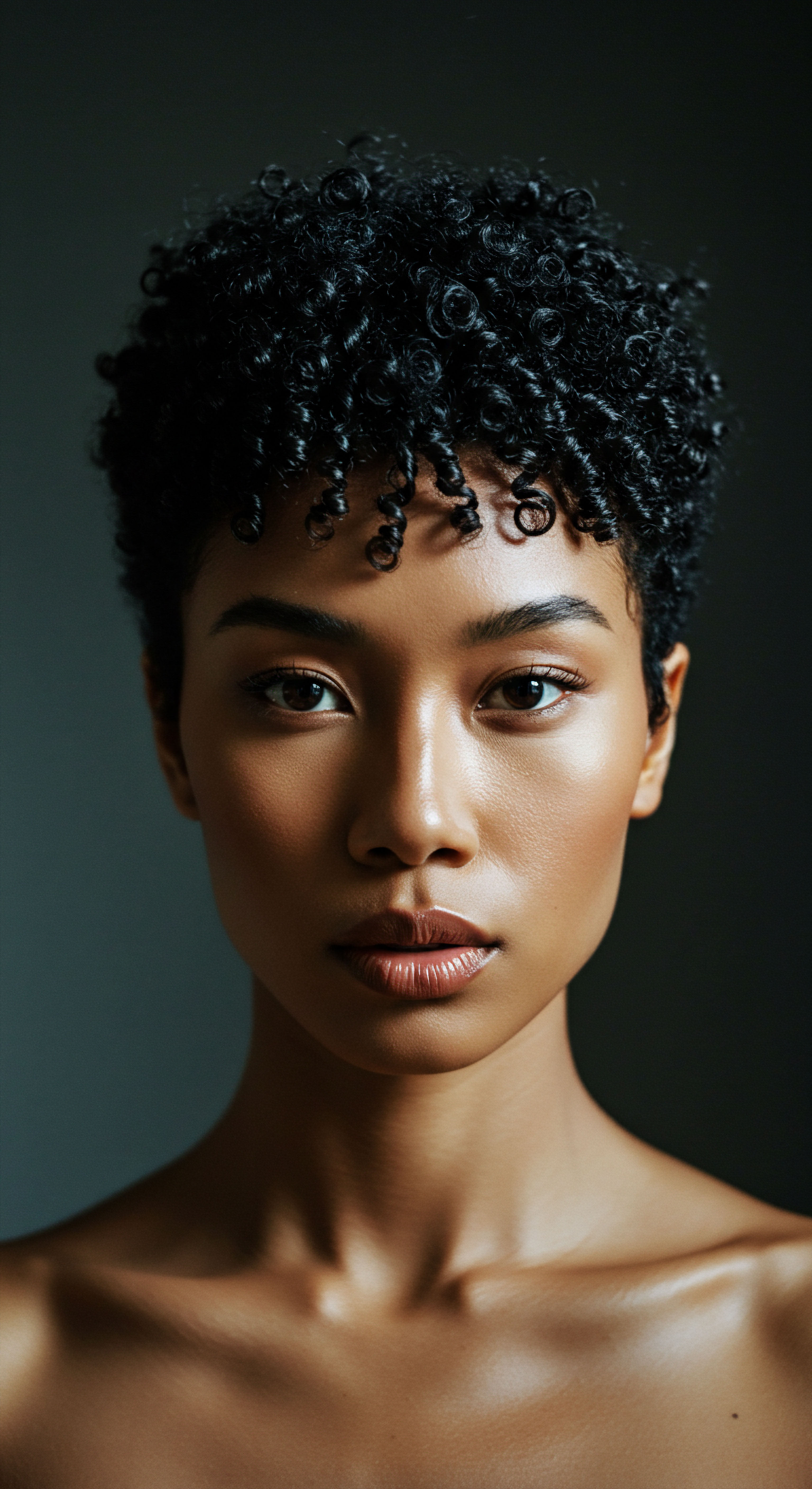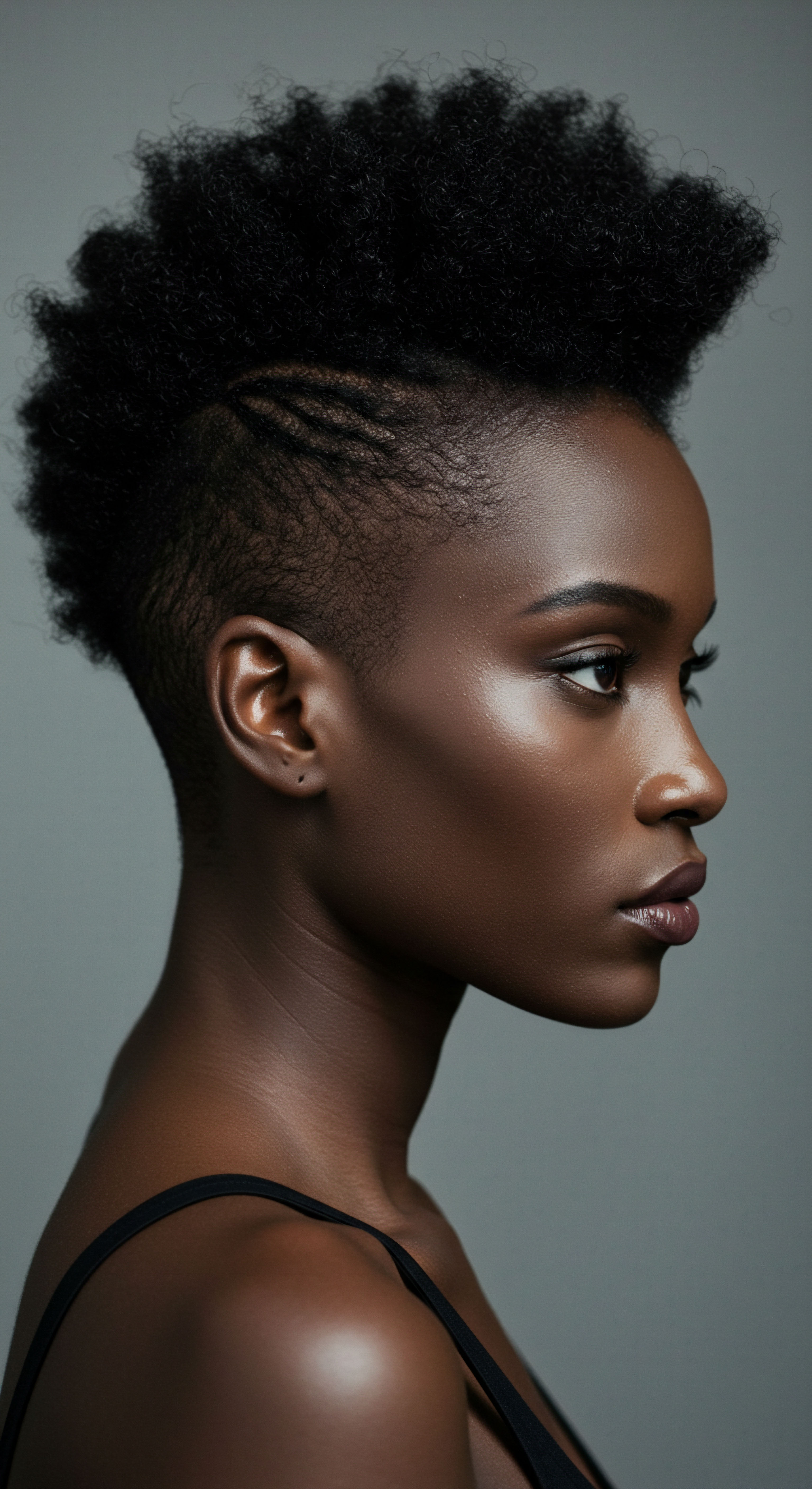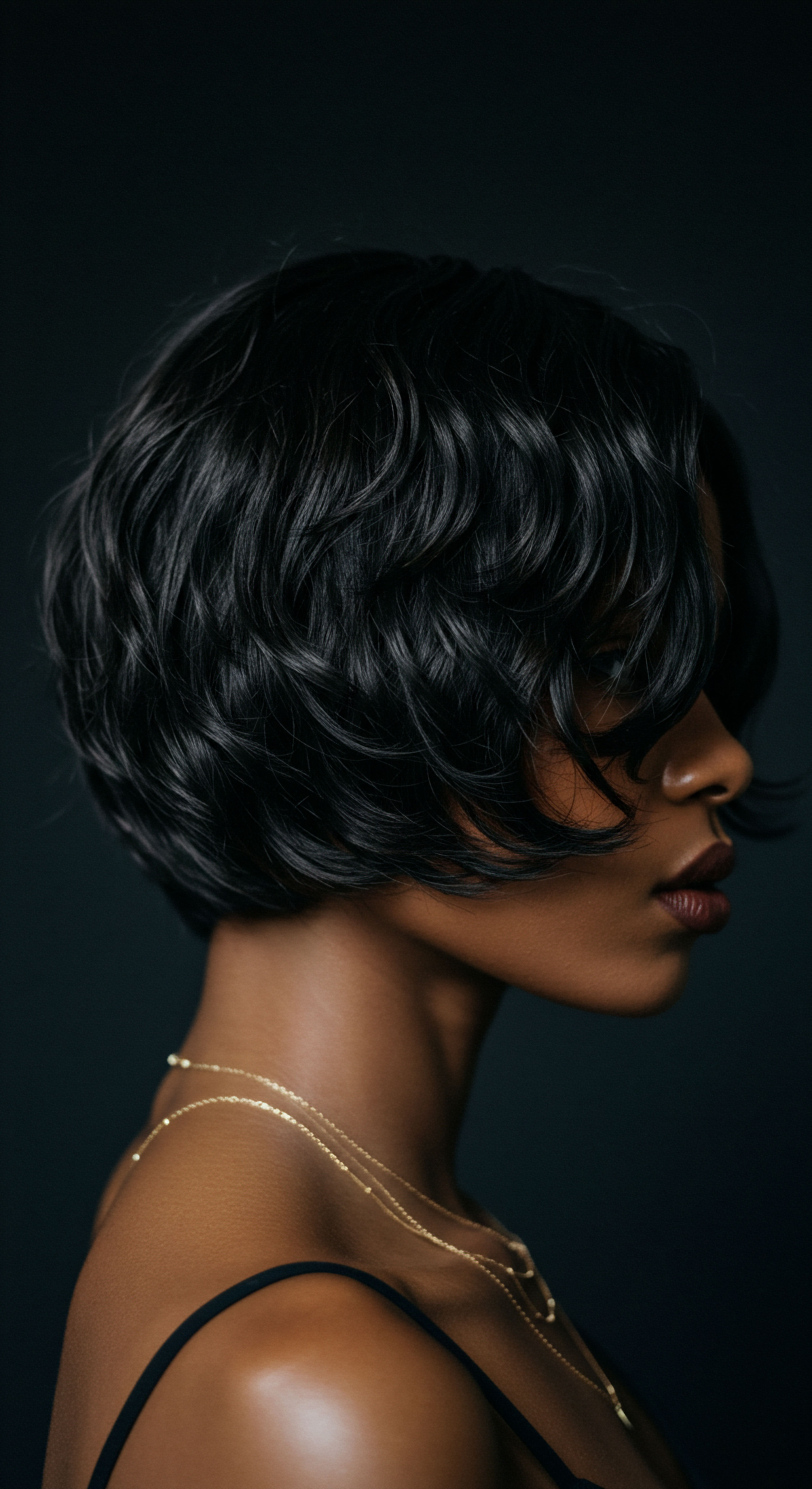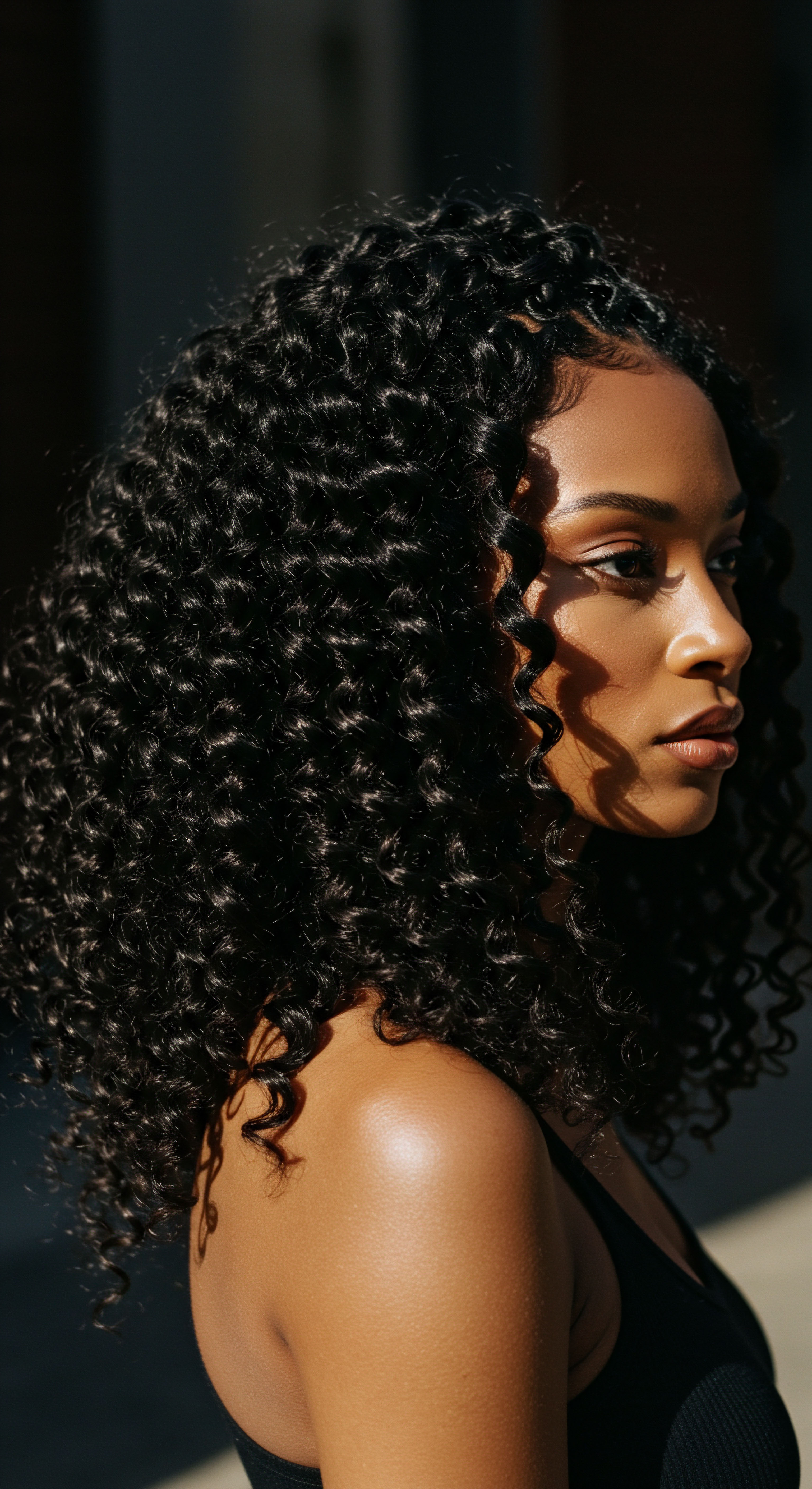
Roots
The story of head wraps in Africa begins not with a single thread, but with a vibrant spectrum of cultural expressions, each strand contributing to a rich and deeply personal tradition. To truly grasp their historical genesis, we must journey back through time, allowing the gentle whisper of ancient practices to guide our understanding. These head coverings, far from being mere adornments, emerged from a profound connection to self, community, and the spiritual world. They are a testament to ingenuity, protection, and the silent language of identity spoken across generations.

Ancient Origins and Early Expressions
The earliest indications of head coverings across the African continent point to a practical necessity, born from the continent’s diverse climates. From the arid expanses of the Sahara to the humid rainforests, safeguarding the hair and scalp from sun, dust, and elements was a sensible measure. Yet, even in these foundational uses, an artistry began to bloom.
Evidence from ancient Nubian and Egyptian art reveals head coverings worn by royalty, signifying status and perhaps a connection to divine power. These early examples suggest that even in their most rudimentary forms, head wraps held meaning beyond simple utility.
As civilizations grew, so too did the sophistication of these coverings. In various West African societies, the head itself held immense spiritual significance, often considered the seat of one’s spirit, destiny, and connection to the ancestors. Covering the head, therefore, became an act of reverence, a way to shield and honor this sacred space. This belief system propelled the evolution of head wraps from practical items to powerful symbols of spiritual alignment and communal belonging.
Head wraps in Africa began as practical coverings, yet swiftly blossomed into profound expressions of cultural identity and spiritual reverence.

Materials and Techniques
The materials used for early head wraps varied significantly across regions, reflecting local resources and trade networks. Natural fibers like cotton, raffia, and bark cloth were common, often dyed with pigments derived from plants, minerals, and insects. The techniques of preparing, spinning, and weaving these materials were passed down through familial lines, becoming integral parts of a community’s heritage. The patterns and colors chosen were rarely arbitrary; they frequently carried coded messages, identifying one’s ethnic group, social standing, or even personal mood.
Consider the intricate dyeing processes that produced the deep indigos of West Africa or the earthy reds and browns of other regions. These colors, often achieved through laborious natural methods, added layers of meaning and aesthetic value to the head wraps. The way the fabric was treated—whether starched, beaten for softness, or adorned with shells and beads—further spoke to the wearer’s status and the occasion.
The creation of head wraps was not merely a functional task; it was a craft that demanded skill and an understanding of the material’s potential.
- Cotton ❉ A versatile fiber, widely cultivated and traded across the continent, allowing for a range of textures and weaves.
- Raffia ❉ Derived from palm leaves, particularly valued in Central and West Africa for its strength and natural sheen, often used for more structured wraps or hats.
- Bark Cloth ❉ Utilized in regions where trees like the Mutuba were abundant, providing a soft, pliable material with unique textural qualities.

Ritual
As we move from the foundational understanding of head wraps, we approach a deeper layer of their historical presence ❉ their integration into the daily rhythms and ceremonial moments of African life. These are the practices that elevate a simple piece of cloth to a significant cultural artifact, where each fold and knot carries a whisper of tradition and purpose. Understanding these applications offers a window into the nuanced ways communities expressed identity, celebrated milestones, and navigated social landscapes through the quiet artistry of head coverings.

Daily Practices and Social Significance
In many African societies, head wraps served as an everyday uniform, yet their casual wear held a deeper social resonance. A woman’s head wrap could immediately signal her marital status, age, or social standing within the community. For instance, a particular style might signify a newlywed, while another might mark a respected elder. This visual language allowed for a silent, yet clear, communication of an individual’s place and role.
Beyond status, head wraps often denoted a woman’s readiness for the day, a sense of being “put together” and respectful of her surroundings. They were a practical solution for managing hair, especially textured hair, in environments where elaborate styling might not always be feasible daily. This blending of practicality with profound cultural meaning highlights the organic growth of the head wrap tradition.
Head wraps became integral to daily life, silently communicating social standing and marking significant personal moments.

Ceremonial and Spiritual Uses
The head wrap’s role deepened considerably during ceremonial occasions, acting as a visual anchor for rites of passage, religious observances, and celebrations. During weddings, elaborate head wraps might be worn by the bride and female relatives, symbolizing blessings, new beginnings, and communal joy. In funeral rites, specific muted colors or styles could denote mourning and respect for the departed.
For some spiritual practices, the head wrap acted as a conduit or a protective barrier, assisting in meditation or shielding the wearer during spiritual ceremonies. In traditional African religions, new initiates might wear white headscarves continuously, signifying their purity and dedication to their spiritual path. This sacred dimension elevates the head wrap beyond fashion, rooting it firmly in the spiritual bedrock of many African cultures.

Styles and Meanings Across Regions
The sheer diversity of head wrap styles across Africa speaks volumes about the continent’s cultural richness. What is known as a ‘gele’ in Nigeria, with its towering, sculptural forms, might be called a ‘duku’ in Ghana or a ‘doek’ in South Africa. Each name carries with it a distinct history, tying the head wrap to the specific traditions and aesthetic preferences of its people. These styles are not static; they adapt, incorporating new materials, techniques, and influences while retaining their core cultural significance.
Consider the varying methods of tying ❉ some involve intricate pleats and folds that require immense skill, while others are simpler, more casual wraps. The choice of fabric, too, plays a part. Luxurious silks might be reserved for grand events, while sturdy cottons are for everyday wear. This regional specificity means that understanding the historical origin of head wraps is a journey through a multitude of localized traditions, each with its own story to tell.
| Region/Country Nigeria (Yoruba) |
| Common Name Gele |
| Region/Country Ghana |
| Common Name Duku |
| Region/Country South Africa |
| Common Name Doek |
| Region/Country Botswana |
| Common Name Tukwi |
| Region/Country Zimbabwe (Shona) |
| Common Name Dhuku |
| Region/Country Mali |
| Common Name Musuro |
| Region/Country These terms represent a fraction of the diverse names used across the continent. |

Relay
Stepping into the more complex strata of head wrap history reveals not just their origins in utility and tradition, but their profound capacity for adaptation, defiance, and identity in the face of immense change. The journey of the head wrap from an indigenous African expression to a symbol of resistance and a marker of heritage in the diaspora is a powerful testament to its enduring spirit. This section delves into the intricate ways these coverings have relayed messages of resilience, culture, and self-determination through periods of profound societal upheaval, particularly the transatlantic slave trade and colonialism.

A Silent Language of Resistance
The arrival of European colonial powers brought a forceful imposition of new social orders, often seeking to dismantle indigenous African cultural practices. Yet, the head wrap, rather than fading, became a quiet yet potent instrument of defiance. In many instances, colonial authorities attempted to regulate or ban traditional African dress, including head coverings, seeing them as signs of “savagery” or a refusal to assimilate. However, these efforts frequently backfired.
In the diaspora, particularly during the era of enslavement, the head wrap acquired additional, layered meanings. Stripped of their ancestral homes and often forbidden from maintaining traditional hairstyles, enslaved African women found in the head wrap a means of preserving a piece of their identity. It offered practical protection for hair that could not be easily cared for, but more importantly, it served as a visual link to a stolen heritage. Scholars like Helen Bradley Griebel describe the head wrap as a “helmet of courage,” signifying a connection to a true homeland and acting as a “uniform of rebellion” against the loss of self-definition.

How Did Head Wraps Become a Symbol of Protest in the Diaspora?
One striking historical instance that illuminates the head wrap’s role as a symbol of protest occurred in 18th-century colonial Louisiana. In 1786, Governor Esteban Rodriguez Miró enacted the “Tignon Law,” a decree that mandated women of African descent, whether enslaved or free, to cover their hair with a knotted headdress, or “tignon,” and to refrain from “excessive attention to dress.” The law’s stated purpose was to control women of color who were perceived as dressing too elegantly or attracting too much attention, thus threatening the established social order and potentially competing with white women for status.
However, the women of African descent in Louisiana met this oppressive legislation with a remarkable act of sartorial insurgency. Instead of allowing the tignon to become a badge of dishonor, they transformed it into a vibrant expression of beauty, wealth, and creativity. They adorned their tignons with rich, colorful fabrics, sometimes incorporating jewels and feathers, tying them in elaborate, artistic knots that drew even more attention.
Historian Carolyn Long notes that these “bright reds, blues, and yellows of the scarves, and the imaginative wrapping techniques employed by their wearers, are said to have enhanced the beauty of women of color.” This deliberate transformation of a symbol of subjugation into a statement of proud self-assertion stands as a powerful testament to the resilience and creative spirit of these women, directly stemming from the deep-seated cultural significance of head coverings from their African ancestry. This act of “colorful protest” not only defied the law’s intent but solidified the head wrap’s enduring association with resistance and identity for generations to come.
This historical episode underscores a broader pattern ❉ when external forces sought to diminish or control the identity of African people, the head wrap often became a visible marker of unbroken spirit. It was a silent declaration of cultural continuity, a way to hold onto a piece of self amidst systematic efforts to erase it.

Modern Resurgence and Global Influence
In contemporary times, the head wrap continues its dynamic journey, experiencing a significant resurgence globally. This renewed interest is driven by a complex interplay of factors, including a celebration of African heritage, a desire for natural hair protection, and a conscious reclaiming of identity. From high fashion runways to everyday street style, head wraps are recognized as versatile and stylish accessories.
This modern iteration often carries the echoes of its historical weight. For many, wearing a head wrap today is a conscious choice to connect with ancestral traditions, to celebrate the beauty of textured hair, and to stand in solidarity with a legacy of strength and self-possession. It speaks to a growing awareness and appreciation for the rich cultural tapestry from which these coverings originate.
- Cultural Identity ❉ A conscious choice to display connection to African heritage and ancestral practices.
- Hair Protection ❉ A practical method for shielding textured hair from environmental elements and for preserving styles.
- Fashion Statement ❉ An artistic expression that merges traditional aesthetics with contemporary trends.
The global reach of the head wrap also reflects the enduring influence of African aesthetics on world culture. Artists, designers, and everyday individuals are inspired by the diverse styles and profound meanings embedded in these coverings. This relay of cultural practice from ancient Africa, through periods of adversity, to its current global presence, showcases the head wrap as a living, breathing testament to enduring human spirit and cultural continuity.

Reflection
The journey through the historical origins of head wraps in Africa unveils far more than the simple story of a garment. It reveals a profound dialogue between practicality and symbolism, between personal expression and communal identity, and between oppression and powerful acts of resistance. These seemingly simple pieces of cloth, shaped by the hands and intentions of countless individuals across centuries, serve as enduring monuments to human creativity, resilience, and the unyielding spirit of culture.
They whisper tales of ancient reverence, of daily life, and of a quiet, persistent rebellion that refused to be silenced. The head wrap, in its myriad forms, remains a vibrant, living connection to a rich past, constantly reinterpreting its meanings while holding fast to the wisdom of its beginnings.

References
- Chico, Beverly. Hats and Headwear Around the World ❉ A Cultural Encyclopedia. ABC-CLIO, 2013.
- Griebel, Helen Bradley. “The African American Woman’s Headwrap ❉ Unwinding the Symbols.” Art, Design, and Visual Thinking, 1999.
- Long, Carolyn. A New Orleans Voudou Priestess ❉ The Legend and Reality of Marie Laveau. University Press of Florida, 2006.
- Fandrich, Ina J. The New Orleans Voudou Priestess ❉ Marie Laveau. Louisiana State University Press, 2005.
- Daniel, Nyamekye. “Head Wraps ❉ History and Evolution.” JD Institute of Fashion Technology, 2021.
- Gould, Virginia M. Chains of Command ❉ Slave Soldiers and English Rule in the Caribbean, 1690-1834. Cambridge University Press, 2012.
- Skeehan, Danielle. The Rhetoric of Hair ❉ Art, Culture, and Resistance. University of Pennsylvania Press, 2019.
- Colomba, A. Head Wraps ❉ A Global Journey from Africa to America. Bloomsbury Publishing, 2017.
- Brown, Gabriele. “The History of Headwraps and Black Culture.” My World is Beautiful, 2023.
- IJRSI. “Analyzing the Significance of Indigenous Hats in Ghanaian Culture.” International Journal of Research and Scientific Innovation (IJRSI), 2019.